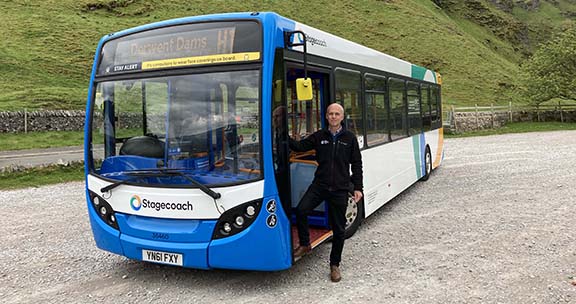- Home
- News
- What’s On
- Activities for Children
- Arts & Crafts
- Autos and Bikes
- Business events
- Car Boot & Auctions
- Charity events
- Churches & Religious
- Comedy
- Dance
- Days out & Local interest
- Education
- Exhibition
- Film
- Gardening & Horticulture
- Health
- Markets & Fairs
- Music
- Nature & Environment
- Spiritual
- Sport
- Talks and Discussions
- Theatre and Drama
- Business
- Local Information
- Jobs
- Deaths
- Charity events
- Contact Us
Bold ambitions for Peak District transport

Quieter roads, well-used bus networks and more walking and cycling opportunities were among the topics discussed at a roundtable event held to consider new approaches to sustainable travel in the Peak District.
Transport emissions are one of the major contributors to climate change in the Peak District National Park and a barrier to achieving net zero targets. Over 80% of visitors currently arrive by car there can be negative impacts on both the National Park landscape and resident communities.
The Peak District National Park Authority convened the Transport Symposium and invited experts from local authorities, charities, transport operators, tourism providers, community groups and major landowners to share their views and explore new ways of reducing private car use in the Peak District.
Recent research shared by officers from the Authority at the event included exploring behaviours of those travelling to the National Park and the difficulties experienced in accessing key visitor destinations by public transport.
There was discussion about better promotion and connectivity of public transport, including super-fast bus routes and demand responsive local networks, plus extending active travel options like walking and cycling and the need to complete flagship projects like the White Peak Loop (a 60-mile/97km multi-user route around the Peak District). There was also support for exploring new and innovative initiatives around transport hubs, park and ride schemes, road charging and trialling seasonal car-free schemes in some honeypot locations.
The Symposium comes shortly after the adoption of the new 5-year Management Plan for the Peak District National Park, which includes a specific action based on improving and promoting sustainable, inclusive and active ways to travel to and around the National Park. Key delivery partners, who all took part in the discussions on Wednesday 1st February, include local authorities, the National Trust, Visit Peak District and Derbyshire, water companies and Buxton Town Team.
Chair of the National Park Authority, Andrew McCloy, said: “We all accept that current levels of visitor car use is unsustainable and damaging, but there’s no easy fix and it will require imaginative thinking and some bold actions. The National Park Authority will continue to convene and show leadership in this area, but we all need to work together to come up with the solutions and then make sure they are delivered. It is our collective responsibility to get this right.”
Roger Clarke from the Hope Valley Climate Action Group, added: “So-called ‘traffic-free days’ for the National Park are just one idea that the Action Group would be highly supportive of, and it was great to see that this caught the imagination of many of those at the event.”
Tom Hendry, from the Chatsworth Estate added: “We’re delighted to be involved with an initiative that is working to deliver improved quality of life and wellbeing for the many local communities on our doorstep.”
Jo Dilley, Managing Director of Visit Peak District & Derbyshire said: “This was a hugely positive event. Delivering sustainable transport solutions is fundamental to growing the tourism economy of the Derbyshire and the Peak District – so now let’s get on and do it!”.
Partners and stakeholders will continue to further develop the ideas presented at the event as part of the National Park Management Plan sustainable transport framework over the next 5 years.

You must be logged in to post a comment Login